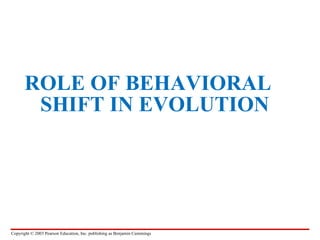
Role Of Behavior In Evolution 1
- 1. ROLE OF BEHAVIORAL SHIFT IN EVOLUTION
- 10. Constructing A Unified Framework , to combine both the Hypotheses 1. Behavior as a Driver of Evolution 2. Behavior as an Inhibitor of Evolution
- 11. The Two Opposing Hypotheses Evolutionary Change Evolutionary Stasis
- 12. Both propose that behaviors affect evolutionary processes by altering selection pressures (paths to and from 4a and paths to and from 5b). The gray boxes highlight two areas where mechanisms have not been made explicit Evolutionary Change Evolutionary Stasis
- 19. Acceptance that behaviors are important in evolution in current evolutionary theory is apparent from the Recognition that behavior can affect evolutionary change is evident in models which are the basis for population genetics, such as in the assumptions of Hardy-Weinberg
- 26. Lactase in Adult humans: Some human populations descended from cattle raising cultures provide a possible example of the power of behavior to drive the fixation of genes for lactose utilization. Most members of these populations (i.e., Northern European and some African populations ) differ from other people and animals by possessing lactase in intestine as adults.
- 27. Lactase in Adult humans: The enzyme is apparently the result of a regulatory mutation whose spread through these populations was fostered by the selection pressure imposed by a new culturally transmitted behavior-namely, the consumption of cows' milk by adults. This practice presumably began only after cattle were domesticated, about 10,000 years ago.
- 28. The High Rate of Anatomical Evolution in Birds and Mammals
- 32. Consistent with this hypothesis, we demonstrate a correlation between relative brain size and rate of anatomical evolution .
- 38. The challenge for future studies in this area is to determine how different types of behaviors (e.g., social behaviors versus habitat selection) and different types of behavioral shifts (e.g., shifts due to learning versus shifts due to selection) affect selection pressures in the short term to ultimately impact the rate of evolutionary diversification.